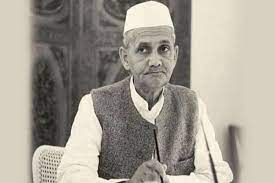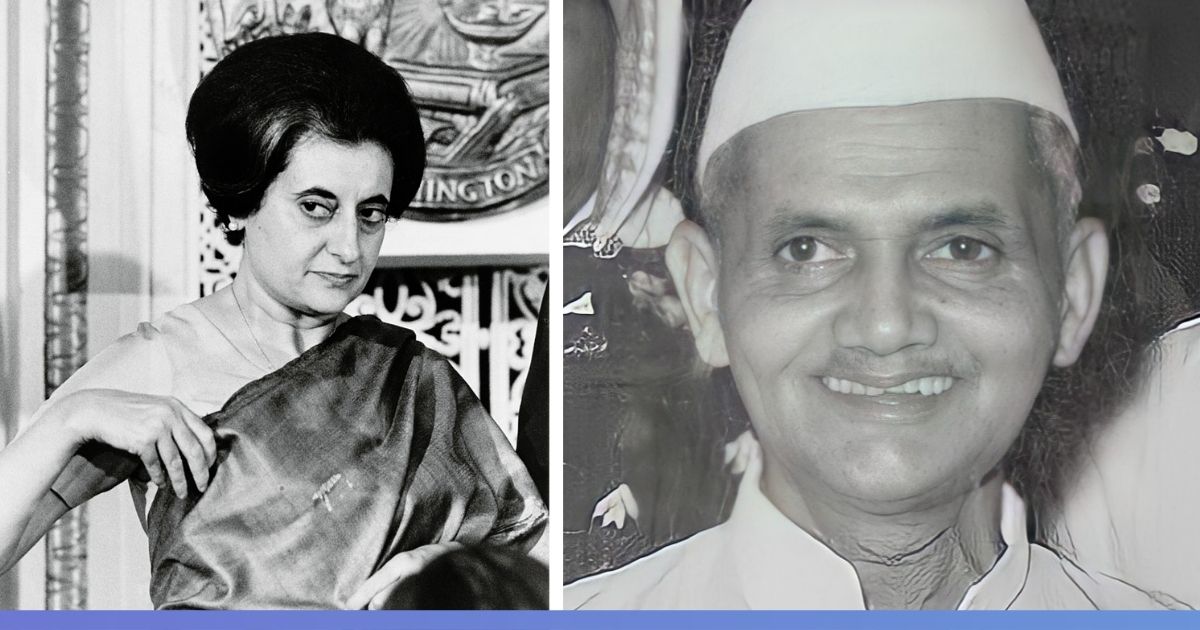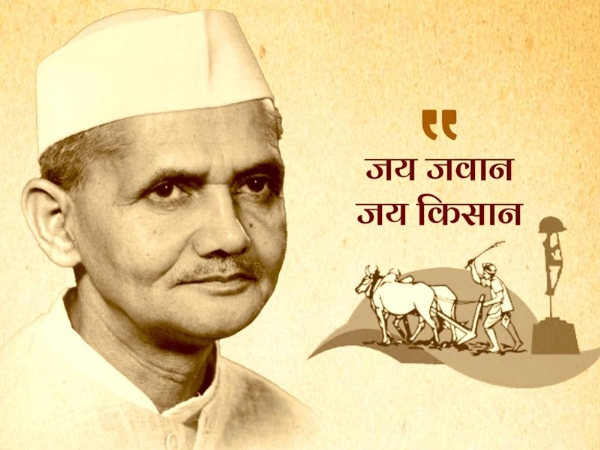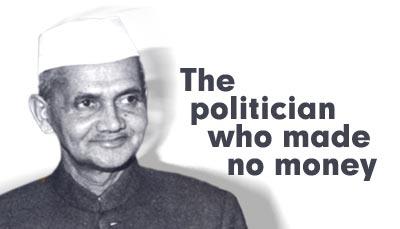S
Shruti Dasgupta
Guest
Today marks Lal Bahadur Shastri Ji’s birth anniversary. Born on 2nd October 1904, in Mughalsarai, Uttar Pradesh, he was a man of simplicity, integrity, and unwavering dedication to India’s progress. Let’s celebrate the remarkable contributions to Bharat by the enigmatic leader.
Lal Bahadur Shastri parents were Ramdulari Devi and Sharada Prasad Shrivastava. Lal Bahadur discarded his last name to reject the prevailing caste-bias in India. Thus, upon graduating from Kashi Vidyapeeth in Varanasi in 1925, he was bestowed with the title “Shastri” which signifies his proficiency as a scholar or someone proficient in Dharmic Texts.
Weathering many financial difficulties, Shastri Ji managed to continue his education and went on to complete a degree at the University of Allahabad. Thereafter, he began his early involvement in social and political issues at the university. The academic environment in the university supported the Indian Independence Movement. Thus, he too became actively involved in India’s struggle against British rule. As Lal Bahadur Shastri’s early political career unfolded, he emerged as a dedicated and disciplined leader. His simplicity and integrity became hallmarks of his public image, thereby, earning him the trust and respect of his peers.

PC India.Com
Lal Bahadur Shastri’s journey began from modest beginnings in Mughalsarai to the highest electoral office of independent India. His service of the nation during challenging times distinguishes him as the key figure in Indian politics and history.
In the post-independence era, Shastri Ji became the Parliamentary Secretary in Uttar Pradesh. Later on he held important portfolios like Minister of Police and Transport, Railways Minister, Minister of Commerce and Industry, and Minister of Home Affairs.
The untimely death of PM Nehru in 1964 left a power vacuum in the nation. This catapulted Shastri Ji as a candidate for the position of Prime Minister of India. Despite his mild-mannered demeanor, Shastri Ji was an ideal and appealing candidate for the post of PM. Some speculate that he was probably chosen to fail. Moreover, some speculate that he was to be an easy stepping stone for Indira Gandhi. Whatever the reason for Congress to choose him, Shastri Ji was determined to be the best version of himself as the Prime Minister of India.
Shastri Ji’s tenure was wrought with challenges in the changing national and global political arena. However, this man of small height stood tall and steadfast in his ideology and beliefs.
Consequently, he was instrumental in modernizing the agricultural practices of Punjab, Haryana, and Uttar Pradesh.

PC The Logical Indian
These policies won the hearts of the middle-class workers, the farmers, and the industrialists at the same time. This was the pivotal moment of Shastri’s rise which disturbed the Nehru-Gandhi family’s dynastic political balance. Some analysts speculate that these policies and his rising popularity laid the foundation for his mysterious death.
Shastri Ji fostered closer relations with Burma, a move that gained significance in the geopolitical landscape. His visited Rangoon in 1965 to re-establishing cordial relations with Burma’s military government. Such a move showcased his diplomatic acumen.
Under his leadership, India inked the Indo-Ceylon Agreement and the Bandarnaike-Shastri with Ceylon in 1964. This agreement significantly influenced the status and future of those who were in India but lived in Ceylon. Most importantly, it particularly affected the descendants of Indian tea estate laborers transported to Ceylon during the British rule.

PC NewsBharati
Amidst the Indo-Pak war of 1965, Shastri Ji’s immortal slogan “Jai Jawan, Jai Kisaan” echoed across the nation.
After the major conflict erupted on August 1, 1965; India responded by crossing the Ceasefire Line and even the International Border near Lahore. The ensuing intense battles in Punjab and Kashmir held the nations’s breath. When the Indo-Pak war concluded on September 23, 1965; Shastri Ji had ensured that the ‘Tiranga’ flew high across the border into Pakistan.
Lal Bahadur Shastri’s sudden demise in Tashkent on January 11, 1966, a day after signing the peace treaty, left behind a legacy of crisis in the nation. The circumstances surrounding his death contributed to the birth of numerous conspiracy theories. Even today, claims of foul play are shouted along with Shastri Ji’s name. However, Lal Bahadur Shastri is hailed as one of India’s most esteemed Prime Ministers today. He is celebrated as a visionary leader responsible for India’s inclusive approach contrary to Pakistan’s use of religion as a political tool.

PC WordPress @ Jitesh Trapasiya
Despite being a cabinet minister in the 1950s and thereafter holding various political posts, Shastri’s financial situation was not affluent at the time of his death. He only owned an old car bought which was bought in instalments from the government. Moroever, at his death he still had outstanding payments for the car. Compare this with the Nehru-Gandhi family’s affluence. Who was the true public servant, PM Nehru or Shastri Ji?
Recent years have seen an increased interest in the forgotten heroes of Bharat. Shastri Ji’s life and death have regained relevance in the new Bharat. Documentaries and films like “Homage to Lal Bahadur Shastri”, “Jai Jawaan Jai Kisaan”, and “The Tashkent Files” delve into different aspects of his persona and death. Additionally, television series like “Pradhanmantri” dedicate episodes to his term. Thus, Bharat remembers this quite and simple leader, who fought to build the nation and protect its people.
The Sleeping Bhartiya has woken up to the fact the real leaders do not subtly sell the nation to accumulate unaccounted-for wealth. Lal Bahadur Shastri’s life is a testament to the values of a public servant. His simplicity, integrity, and selfless service to the nation showcase him as a dedicated leader. Shastri Ji continues to inspire generations of new-age Indians. On this day, we remember him not just as a Prime Minister but as a symbol of selflessness and ethical governance.
The post Lal Bahadur Shastri: An Unsung Legacy appeared first on The Jaipur Dialogues.
Continue reading...
The Mystery Behind the Epithet: SHASTRI
Lal Bahadur Shastri parents were Ramdulari Devi and Sharada Prasad Shrivastava. Lal Bahadur discarded his last name to reject the prevailing caste-bias in India. Thus, upon graduating from Kashi Vidyapeeth in Varanasi in 1925, he was bestowed with the title “Shastri” which signifies his proficiency as a scholar or someone proficient in Dharmic Texts.
Weathering many financial difficulties, Shastri Ji managed to continue his education and went on to complete a degree at the University of Allahabad. Thereafter, he began his early involvement in social and political issues at the university. The academic environment in the university supported the Indian Independence Movement. Thus, he too became actively involved in India’s struggle against British rule. As Lal Bahadur Shastri’s early political career unfolded, he emerged as a dedicated and disciplined leader. His simplicity and integrity became hallmarks of his public image, thereby, earning him the trust and respect of his peers.
The Journey to the Pinnacle
PC India.Com
Lal Bahadur Shastri’s journey began from modest beginnings in Mughalsarai to the highest electoral office of independent India. His service of the nation during challenging times distinguishes him as the key figure in Indian politics and history.
In the post-independence era, Shastri Ji became the Parliamentary Secretary in Uttar Pradesh. Later on he held important portfolios like Minister of Police and Transport, Railways Minister, Minister of Commerce and Industry, and Minister of Home Affairs.
The untimely death of PM Nehru in 1964 left a power vacuum in the nation. This catapulted Shastri Ji as a candidate for the position of Prime Minister of India. Despite his mild-mannered demeanor, Shastri Ji was an ideal and appealing candidate for the post of PM. Some speculate that he was probably chosen to fail. Moreover, some speculate that he was to be an easy stepping stone for Indira Gandhi. Whatever the reason for Congress to choose him, Shastri Ji was determined to be the best version of himself as the Prime Minister of India.
Domestic and Economic Policies
Shastri Ji’s tenure was wrought with challenges in the changing national and global political arena. However, this man of small height stood tall and steadfast in his ideology and beliefs.
Shastri Ji championed the White Revolution in india. his support helped Amul co-operative BECOME THE BEHEMOTH IT IS TODAY.
Shastri Ji initiated the Green Revolution in 1965 in India. He aimed at enhancing food grain production to counter the severe deficiency of food grains.
Consequently, he was instrumental in modernizing the agricultural practices of Punjab, Haryana, and Uttar Pradesh.

PC The Logical Indian
These policies won the hearts of the middle-class workers, the farmers, and the industrialists at the same time. This was the pivotal moment of Shastri’s rise which disturbed the Nehru-Gandhi family’s dynastic political balance. Some analysts speculate that these policies and his rising popularity laid the foundation for his mysterious death.
Lal Bahadur Shastri’s Foreign Policies
Relations with the Rangoon
Shastri Ji fostered closer relations with Burma, a move that gained significance in the geopolitical landscape. His visited Rangoon in 1965 to re-establishing cordial relations with Burma’s military government. Such a move showcased his diplomatic acumen.
Indo-Ceylon Agreement
Under his leadership, India inked the Indo-Ceylon Agreement and the Bandarnaike-Shastri with Ceylon in 1964. This agreement significantly influenced the status and future of those who were in India but lived in Ceylon. Most importantly, it particularly affected the descendants of Indian tea estate laborers transported to Ceylon during the British rule.
War and Peace – Indo-Pak War of 1965

PC NewsBharati
Amidst the Indo-Pak war of 1965, Shastri Ji’s immortal slogan “Jai Jawan, Jai Kisaan” echoed across the nation.
This powerful rallying SLOGAN resonated with the masses of India during the war.
Moreover, It reiterated his belief in the pillars of Bharat: the man who FEEDS THE NATION ‘The Kisaan’ and the man PROTECTS THE NATION ‘The Jawan’.
After the major conflict erupted on August 1, 1965; India responded by crossing the Ceasefire Line and even the International Border near Lahore. The ensuing intense battles in Punjab and Kashmir held the nations’s breath. When the Indo-Pak war concluded on September 23, 1965; Shastri Ji had ensured that the ‘Tiranga’ flew high across the border into Pakistan.
Legacy and a Mysterious Demise
Lal Bahadur Shastri’s sudden demise in Tashkent on January 11, 1966, a day after signing the peace treaty, left behind a legacy of crisis in the nation. The circumstances surrounding his death contributed to the birth of numerous conspiracy theories. Even today, claims of foul play are shouted along with Shastri Ji’s name. However, Lal Bahadur Shastri is hailed as one of India’s most esteemed Prime Ministers today. He is celebrated as a visionary leader responsible for India’s inclusive approach contrary to Pakistan’s use of religion as a political tool.

PC WordPress @ Jitesh Trapasiya
Despite being a cabinet minister in the 1950s and thereafter holding various political posts, Shastri’s financial situation was not affluent at the time of his death. He only owned an old car bought which was bought in instalments from the government. Moroever, at his death he still had outstanding payments for the car. Compare this with the Nehru-Gandhi family’s affluence. Who was the true public servant, PM Nehru or Shastri Ji?
Enduring Presence in The New Bharat
Recent years have seen an increased interest in the forgotten heroes of Bharat. Shastri Ji’s life and death have regained relevance in the new Bharat. Documentaries and films like “Homage to Lal Bahadur Shastri”, “Jai Jawaan Jai Kisaan”, and “The Tashkent Files” delve into different aspects of his persona and death. Additionally, television series like “Pradhanmantri” dedicate episodes to his term. Thus, Bharat remembers this quite and simple leader, who fought to build the nation and protect its people.
The Sleeping Bhartiya has woken up to the fact the real leaders do not subtly sell the nation to accumulate unaccounted-for wealth. Lal Bahadur Shastri’s life is a testament to the values of a public servant. His simplicity, integrity, and selfless service to the nation showcase him as a dedicated leader. Shastri Ji continues to inspire generations of new-age Indians. On this day, we remember him not just as a Prime Minister but as a symbol of selflessness and ethical governance.
The post Lal Bahadur Shastri: An Unsung Legacy appeared first on The Jaipur Dialogues.
Continue reading...
